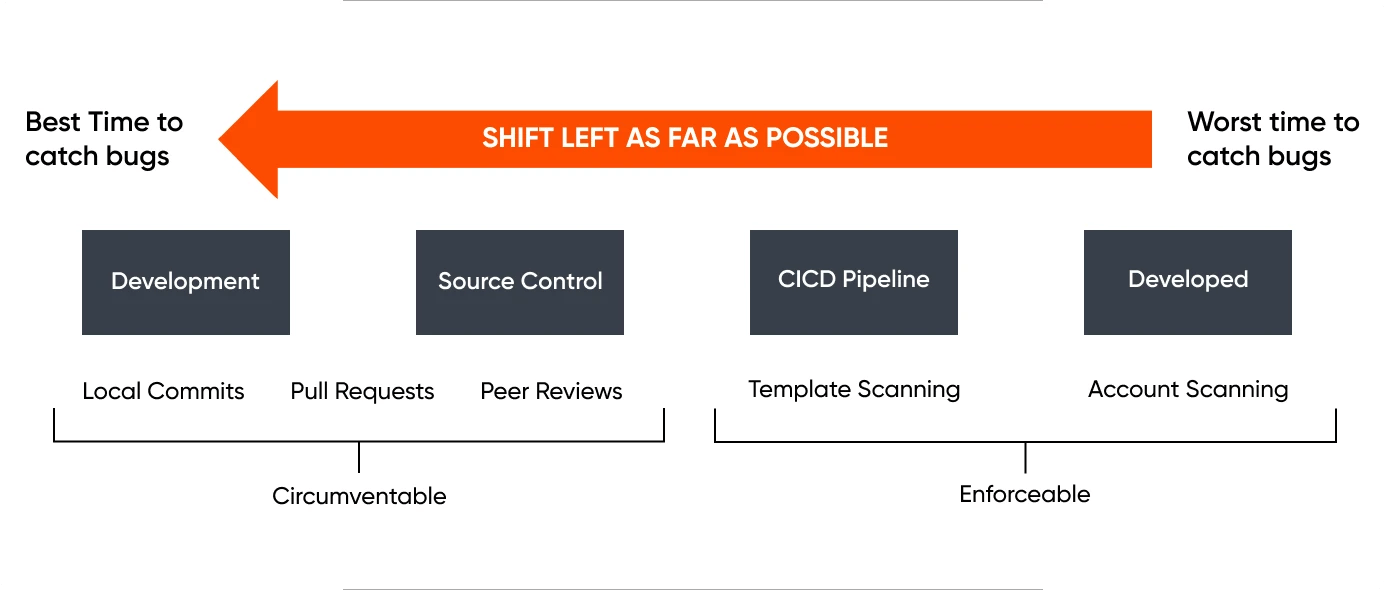According to the World Quality Report, the largest research study assessing the current trends of QE practices, Product Quality Engineering (PQE) offers several benefits.
- Accelerated Software Delivery: By catching bugs early and often, Product Quality Engineering helps avoid costly reworks and delays while ensuring faster time to market.
- Conservation of Resources: Continuous testing and automation help identify issues before they become major problems, minimizing resource waste.
- Optimized User Experience: PQE isn't just about testing; it's about building quality into every process. This leads to fewer bugs and a smoother user experience.
Product Quality Engineering Principles That Enable Faster Software Delivery
Product Quality Engineering (QE) follows foundational principles, shaping the creation and delivery of software products.
.webp?width=1385&height=941&name=Body%20Image%201%20(1).webp)
Principle 1: Prevention Over Detection
Proactively identifying risks and implementing preventive measures to curb defects ensures smooth delivery.
Principle 2: Shifting Quality Left & Right
Quality is embedded throughout the development lifecycle for holistic effectiveness.
Principle 3: Collaboration & Teamwork
QE facilitates clear communication, shared ownership, early issue identification, continuous feedback, and automation to ensure efficient collaboration.
Principle 4: Continuous Improvement & Adaptation
Regularly refine processes, tools, and methodologies to uphold the highest quality standards.
Principle 5: Measurement & Analysis
Quality metrics such as defect detection rate, user satisfaction ratings, and Net Promoter Score (NPS) are utilized to evaluate practices and inform decisions for continuous improvement.
Principle 6: Promotion Of Quality Culture
Cultivating a collaborative environment where everyone takes ownership of quality and fostering continuous improvement
Principle 7: Business-Driven Testing
QE empowers business owners with the tools and processes to participate in testing activities effectively.
Principle 8: Automation & Innovation
Automated tools and frameworks speed innovation by handling repetitive tasks and letting QA resources concentrate on feature development/rapid iteration. Continuous CI/CD pipeline testing ensures high code quality, cutting costs and time to market.
Principle 9: User-Centric Focus
QE actively addresses usability issues, prioritizes testing based on user needs, and seeks continuous feedback to ensure alignment with user expectations.
A Short Tale: How Spotify Delivered Product Quality At Speed
Spotify, the renowned music streaming service, offers a vast library of songs accessible to over 226 million active users. But it wasn’t long ago when Spotify faced obstacles with launching new features on time and scaling with user needs. Spotify's fragmented technology stack led to inefficiencies and delays, resulting in a 14-day deployment cycle and a 60-day onboarding time for new engineers.
To overcome the challenges, Spotify adopted Quality Engineering Productivity, focusing on optimized code, effective collaboration, efficient resource utilization, and rapid development.
This was made possible by developing and implementing 4 products
-
Backstage: A centralized repository for resources and tools to streamline development and improve collaboration.
-
Golden Paths: standardized bootstrapping for backend services, offering pre-defined configurations and tutorials to ensure faster deployment time and better environment management.
-
Tingle CI/CD: Automates build, deployment, and release within GitHub, freeing engineers for innovation and strategic initiatives.
-
Test-Certification Program: Gamified testing speeds up QA by reporting build time, code coverage, and reliability. It alerts teams to unreliable tests and rewards achievements with badges.
 Source: aws.amazon.com
Source: aws.amazon.com
Consequently, Spotify could handle tens of thousands of builds weekly with shorter delivery cycles. The project setup time for experienced and new developers was reduced to less than 5 minutes.
Quality engineering is about establishing a systematic approach that cultivates a quality-focused mindset, ultimately leading to effective solutions.
How To Get Started With Product Quality Engineering
Product Quality Engineering (PQE) encompasses a wide range of activities, from defining quality standards to monitoring performance and identifying areas for improvement.
Step 1: Describe Quality Objectives
Establish clear, measurable objectives aligned with organizational goals and customer requirements. Identify key performance indicators (KPIs) to track and measure progress towards these goals.
Step 2: Define The Quality Criteria
Gather and analyze customer needs and expectations to define quality criteria. Develop a comprehensive understanding of customer requirements to ensure the final product or service meets expectations.
Step 3: Develop A Quality Plan
Develop a detailed plan outlining the entire quality assurance process. Specify quality control measures, testing procedures, and acceptance criteria.
Step 4: Design For Quality
Integrate quality considerations into the design phase to prevent defects and issues. Conduct design reviews to ensure that products or services meet quality standards.
Step 5: Establish Quality Control
Establish robust quality control processes. Conduct inspections, reviews, and testing at various production or service delivery stages.
Step 6: Continuous Improvement
Implement a culture of continuous improvement by regularly reviewing processes and identifying areas for enhancement. Utilize feedback mechanisms to gather information on defects, customer complaints, and other quality issues.
Step 7: Training & Skill Development
Provide training programs to ensure employees have the necessary skills and knowledge to produce high-quality output.
Step 8: Use Tools & Techniques
Leverage powerful Quality Engineering tools like Jira, Selenium, and Jenkins alongside methodologies like Six Sigma and Statistical Process Control (SPC). Also, implementing Failure Mode and Effects Analysis (FMEA) ensures effective, early issue identification and resolution.
Step 9: Document & Analyze Data
Maintain detailed records of quality-related data, including test results, inspections, and customer feedback. Analyze the data to identify trends, defects' root causes, and improvement opportunities.
Step 10: Customer Feedback & Satisfaction
Monitor customer satisfaction levels and use feedback to drive continuous improvement efforts.
Step 11: Certifications & Compliance
Obtain relevant certifications and ensure compliance with industry standards and regulations.
The order of these steps is flexible and can be adapted to best fit your specific project needs.
How Axelerant Helped Build A Quality-First Portal For One Of USA’s Most Innovative Retail Brands
The customer is a leading American retail company that serves office supplies to businesses through superstores, retail markets, postal, Internet, and partner distribution networks. They needed a portal as a unified hub for its suppliers, merchants, and monetization teams.
The customer offers many programs for suppliers to advertise themselves and improve their brand awareness and sales. Their Partnership Portal would allow stakeholders to attend events and act as a complete campaign management tool.
Axelerant adopted a phased approach, initiating the timely launch of a Minimum Viable Product (MVP), a supplier-facing website for the client's Supplier Summit.
The QE team conducted in-depth requirement analysis, facilitated swift product owner decisions, and ensured the project's phased implementation, contributing significantly to a smooth and timely delivery.
At Axelerant, our experts can help you navigate similar challenges and deliver exceptional products.
Schedule a call to learn more.

Shweta Sharma, Director of Quality Engineering Services
When Shweta isn't at work, she's either on a family road trip across the country or she's dancing with her kids—it's a great combination.
.png)
Vishnu S Kumar, Marketing Associate
A humble and passionate soul who loves to explore the world on his bike—that’s Vishnu. In his free time, you’ll often find him at cafes, sipping coffee and watching different genres of shows.

 We respect your privacy. Your information is safe.
We respect your privacy. Your information is safe.
Leave us a comment